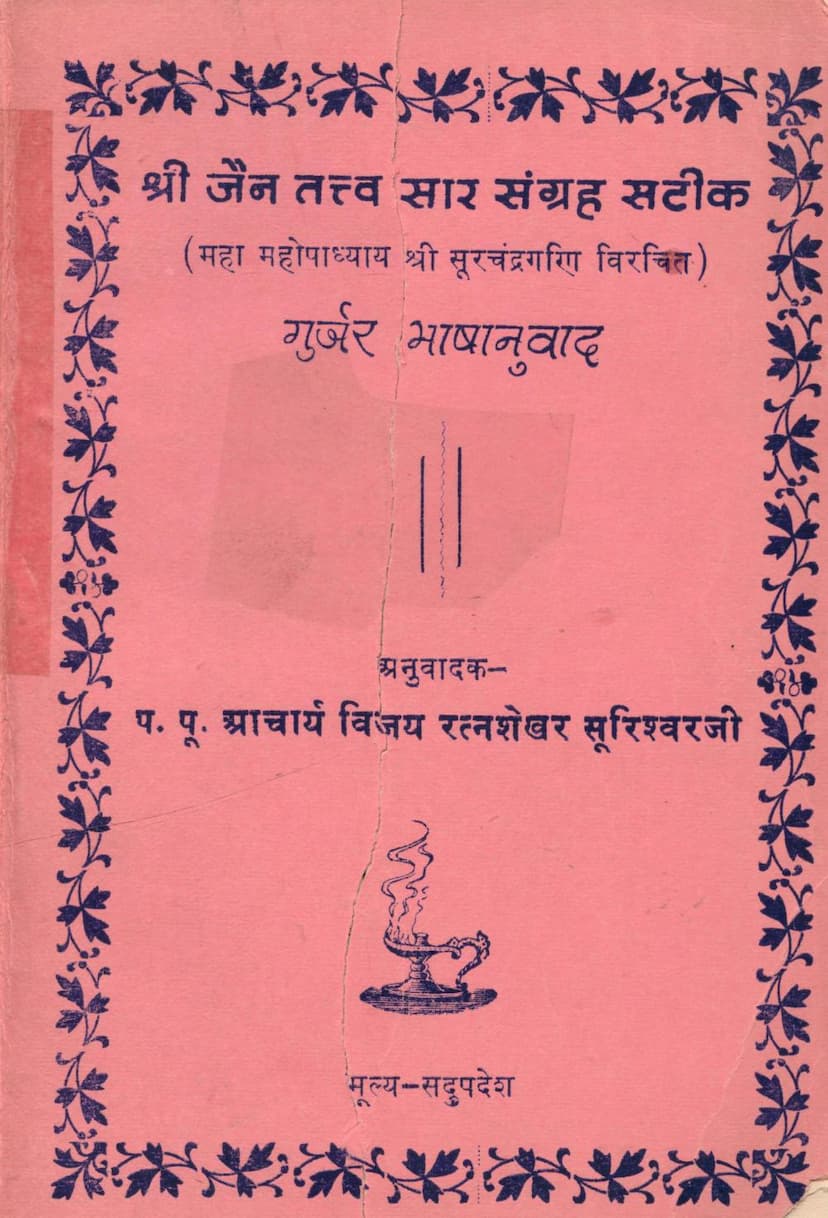Jain Tattva Sar Sangraha Satik
Added to library: September 2, 2025

Summary
Here's a comprehensive summary of the Jain text "Jain Tattva Sar Sangraha Satik" based on the provided pages:
Overview:
"Jain Tattva Sar Sangraha Satik" is a significant Jain philosophical text authored by Mahamahopadhyaya Shri Surachandragani and translated into Gujarati by Acharya Vijay Ratnashekhar Surishwarji. Published by Shri Ranjanvijayji Jain Pustakalay, the book aims to elucidate profound Jain principles in a clear and accessible manner, making complex spiritual concepts understandable to the common reader.
Core Themes and Content:
The book delves into fundamental Jain doctrines, explaining the nature of the soul (Atma) and its relationship with karma. It seeks to provide guidance for spiritual seekers to achieve liberation (Moksha). Key themes and topics covered include:
- Nature of the Soul (Atma): The soul is described as pure, possessing infinite knowledge, perception, character, and energy, like a spotless crystal. However, due to its association with karma since time immemorial, it exists in a state of worldly existence.
- Karma and its Impact: The text explains that karma, which is formless, invisible, and inherently inert (Jad), binds the soul. It details how souls accumulate karma through their actions, leading to suffering and the cycle of birth and death. The unseen nature of karma is emphasized, making it imperceptible to ordinary senses but visible to omniscient beings (Kevalis).
- The Soul-Karma Connection: The book explores the anadi (beginningless) relationship between the soul and karma. It addresses the question of how this connection, despite the different natures of soul (consciousness) and karma (inert), is formed and how it can be severed.
- Path to Liberation (Moksha): The central aim of the text is to outline the path to liberation. It emphasizes that by understanding the true nature of the soul and karma, and by practicing right faith (Samyak Darshan), right knowledge (Samyak Gyan), and right conduct (Samyak Charitra), one can break free from karmic bondage and attain the soul's pure, liberated state.
- Illustrative Examples and Analogies: To simplify complex philosophical points, the author and translator utilize numerous analogies and examples from everyday life, scriptures, and even natural phenomena. These are used to explain abstract concepts like the soul's omnipresence, the bondage of karma, the reasons for suffering, and the means of liberation.
- Rejection of External Controllers: The text implicitly or explicitly rejects the idea of an external creator god in the manner of some other philosophies. It emphasizes that the soul's destiny is determined by its own karma and efforts, rather than the whims of an external deity.
- The Role of Knowledge: The importance of discriminative knowledge (Vivek) is highlighted, as it enables one to distinguish between the real (Sat) and the unreal (Asat), and to understand the true nature of the soul and karma.
- The Cycle of Existence: The text touches upon the vastness of the soul's journey through various life forms and states of existence, emphasizing the pervasiveness of karma and the intricate classifications of living beings (Jivas) according to their sensory faculties and states of existence.
- The Nature of the Soul's Attributes: The book clarifies that the soul's liberation involves the shedding of karmic coverings, leading to the manifestation of its inherent, infinite qualities. The process of spiritual attainment is described as understanding the soul's true self, free from the influence of external substances and passions.
Key Principles Elaborated:
- Syadvada: The Jain principle of conditional predication is reflected in the understanding that each entity has multiple facets and can be viewed from different perspectives.
- Nayas and Pramanas: The text utilizes various logical categories (Nayas) and means of valid knowledge (Pramanas) to explain its philosophical tenets.
- The Five Samavayas: The explanation of how the world functions through the interaction of five essential elements (Dravyas) and five Samavayas (causes) underscores the deterministic yet effort-driven nature of Jain philosophy.
Translator's Contribution:
Acharya Vijay Ratnashekhar Surishwarji's Gujarati translation is praised for its clarity, detailed explanations, and engaging presentation. He has made an effort to simplify the intricate subject matter, ensuring that readers can connect with the text and appreciate its spiritual depth.
Overall Purpose:
"Jain Tattva Sar Sangraha Satik" serves as a valuable resource for anyone seeking to understand the core tenets of Jainism. It aims to dispel ignorance, foster spiritual inquiry, and guide individuals towards self-realization and liberation by illuminating the path of karma and soul purification.